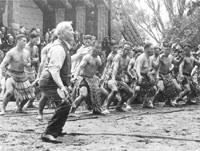Centennial:
1940
During the 1940 centennial, the government made a great show of national
pride and unity at Waitangi. Newspapers talked of Waitangi as the 'cradle
of the nation' and the treaty as the 'foundation of nationhood'. The
treaty and Waitangi began to find a place in the national consciousness,
although for most New Zealanders they had historical interest only.

For a number of Maori leaders,
however, the celebrations provided anopportunity
to challenge the nation's record in race relations. Apirana Ngata
observed that not everyone had something to celebrate, and Waikato tribal
leaders refused to go to Waitangi, even though they had assisted in building
the 30-metre canoe, Nga-toki-mata-whao-rua, that was launched there.

Postwar
Observances
During the Second World War the Waitangi property was
used by the army. In 1947 the navy erected a new flagpole, and
from that year commemorations incorporated a naval ceremony.
By 1950 several hundred attended the annual celebration (as it
was called) on 6 February. Royal visits were to greatly boost public
interest. In late December 1953 the Queen and the Duke of Edinburgh
stopped at the grounds for an hour. The visit captured the public's
imagination: 'At last Waitangi comes into its own', cried the Dominion,
'and New Zealanders must see that its status is maintained and
heightened.'

And they did. Throughout the 1950s the annual ceremonies at Waitangi
expanded, thousands attended, and the Governor-General's speech became
a feature. Forging one nation from the partnership of two races by a sacred
compact was a common theme, but the often expressed ideal of 'one people'
provided an excellent opportunity for Maori to protest at the shortfall
between promise and practice in race relations.
|
![]() Gallery
Gallery ![]() Waitangi
Day
Waitangi
Day